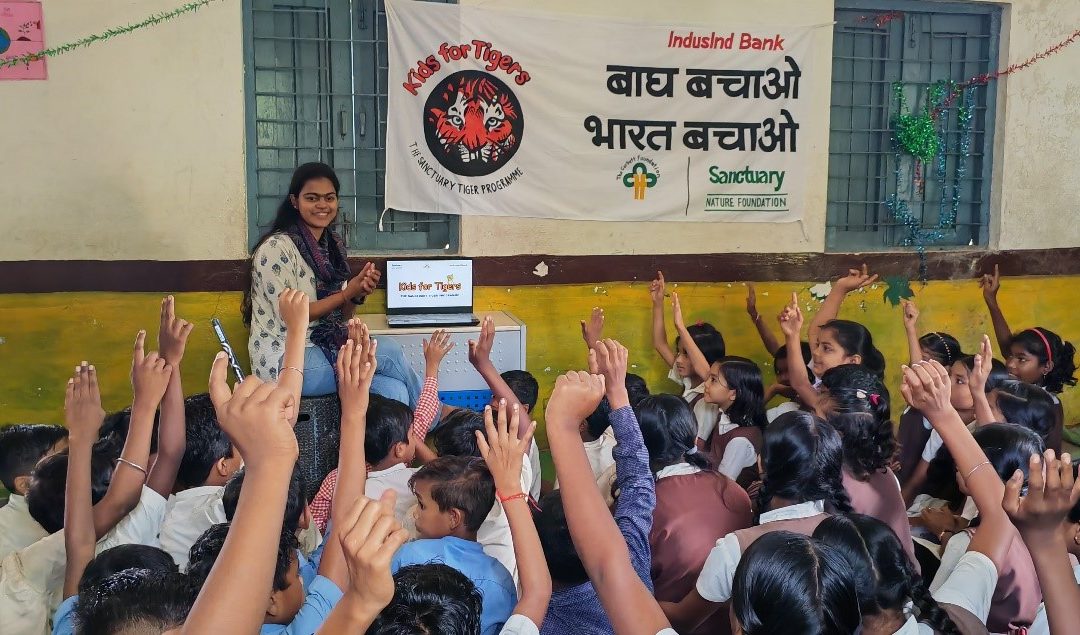Meet Shivangi Bendre, team member of SLTP partner The Corbett Foundation
Shivangi speaks to us about the various conservation projects that she is helping manage in the Kanha Tiger Reserve Landscape, blending hands-on fieldwork with community engagement. Know more about her conservation journey, her learnings and how a typical day looks like for her in the field.
- Tell us more about yourself and what got you interested in working for the environment.
Being an outdoor person, I’ve always been driven by a curiosity to understand the “why” and “how” behind the natural world and its wonders. My love for wildlife and wilderness has turned into a happy addiction from the moment I started working in this field. So, throwback to my first year of BSc at SIES College, Mumbai, when I joined the nature club. Attending guest lectures on wildlife related topics and nature trails were a game changer for me. Little did I know, it was the first step towards discovering my true passion. This passion led me to pursue Masters in Biodiversity, Wildlife Conservation, and Management.
Since college days, my journey has taken me deep into the wilderness, where I’ve developed a broad interest in the ecology of mammals and advocating for their conservation. Over the years, my research has focused on understanding community needs, their connection to nature, and the role of wildlife in their lives. I’ve spent my last few years studying species distribution and human-wildlife interactions with large carnivores like leopards and tigers in the Central Indian Landscape to snow leopards in the majestic Himalayan landscape. From using camera traps to questionnaire-based surveys, I gained hands-on experience and saw the vital connection between communities and wildlife. This understanding pushed me further, aiming to address the challenges faced by both in a shared landscape.
- How does a typical day unfold for you? Tell us a bit about your daily tasks and conservation work.
A typical day in my life as a conservation biologist has always been dynamic and full of variety, blending hands-on fieldwork with community engagement and problem-solving. Each day unfolds differently, this involves visiting restoration sites, checking on plantation activities, ensuring saplings are growing well and keeping track of the progress in areas where we’ve been working to restore native flora, monitoring stall feeding activities, attending tiger or leopard attack cases on cattle along with our para-vet to provide free treatment to injured cattle, conducting awareness programmes in local schools, educating students about biodiversity and the importance of wildlife conservation, conducting biodiversity surveys, etc. Thus, each day brings new challenges and rewards, as I strive to create a harmonious relationship between humans and nature.
- What do you love about your current job?
What I love most about my current job is the Central Indian Landscape and the opportunity to immerse myself in the rich cultural tapestry of local communities and understand their perspectives on wildlife. Engaging with school students is especially rewarding due to their curiosity and enthusiasm that inspires me to share knowledge and foster a deeper appreciation for nature. Restoration work is a new and exciting challenge for me, allowing me to learn about ecological practices while actively contributing to the environment. Also, working with a para-vet has enriched my knowledge of veterinary care, giving me valuable insights into animal health.
But above all, the true privilege lies in stepping away from the hustle and bustle of city life and immersing myself in the serenity of the forest. There’s nothing quite like the peace and beauty of nature to inspire and recharge my spirit.
- Could you share a key learning or experience from the field ?
A key learning from my fieldwork has been the significance of combining practical restoration efforts with a deep understanding of human-wildlife interactions. Engaging with local communities has provided invaluable insights that go beyond theoretical knowledge, highlighting the importance of their experiences in conservation. Interacting with school students living along the forest fringes has been especially impactful because of their curiosity and enthusiasm that inspires me to think creatively about how we can foster a sense of stewardship for the environment in future generations.
This experience has reinforced my belief that education and community involvement are vital for successful conservation efforts.
- Do you feel optimistic about the future of the natural environment of India? Have you experienced a positive change regarding conservation in your area?
Over the past five months, I’ve witnessed the community’s approach towards wildlife conservation in this landscape. The stall feeding & cattle treatment approach not only helps in protecting cattle but also fosters a sense of responsibility towards wildlife conservation within the community. Additionally, offering free treatment for cattle that have been attacked has strengthened trust between locals and conservation efforts. Additionally, I’ve observed enthusiastic participation in restoration work where villagers come together to plant native trees and restore habitats, demonstrating a commitment to the environment which I had not seen as pronounced before.
These experiences have filled me with optimism for the future of India’s natural environment. I can genuinely say I’ve witnessed a positive change in conservation attitudes here.

